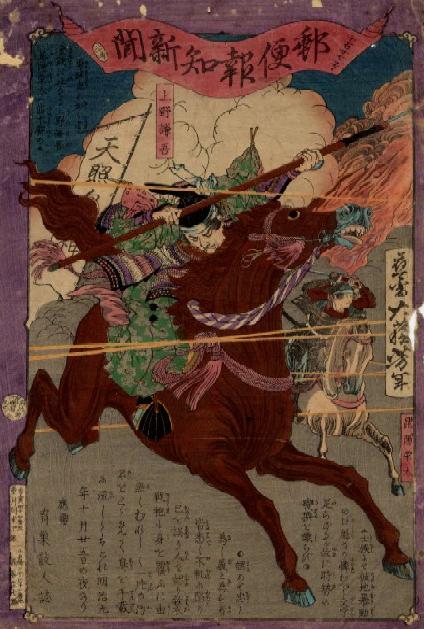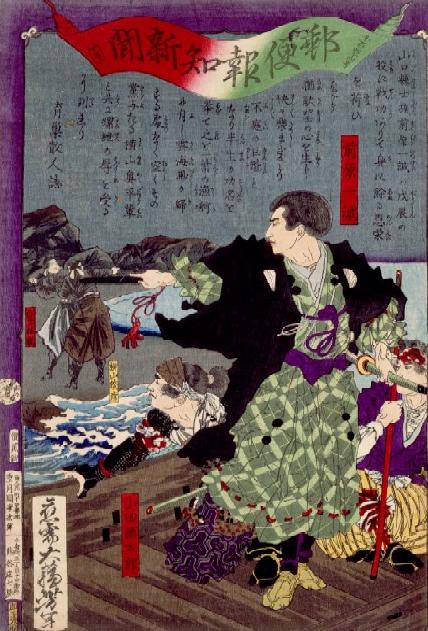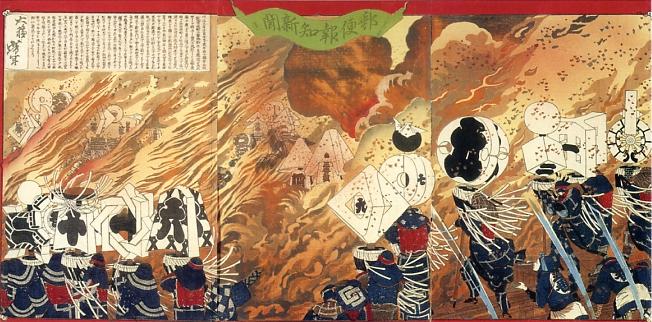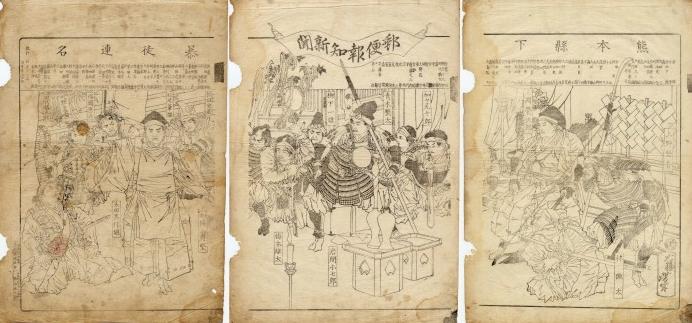YHS news nishikie
Two series, three stages
By William Wetherall
First posted 12 August 2004
Last updated 15 February 2008
General features
Drawers
|
Publisher
|
Disclosures
|
Banners
|
Margins
|
Stories
|
Dates
|
Themes
|
The demise of YHS
Series 1
Stage 0: Unfurled banner and flowing story
|
Stage 1: 1875 approval seals and boxed stories
|
Stage 2: Drawings assisted by Toshimitsu
Series 2
Stage 3: 1876-1877 notification dates
Stage 3 prints
YHS-1127 Kumamoto rebellion
|
TNS-1144 Hagi rebellion
|
TNS-1155 Sukiyacho fire
|
TNS-9001 Kumamoto rioters (unpublished)
General features of YHS prints
Yubin hochi shinbun nishikie (YHS) can be divided into two series representing three stages, based on observations of systematic variations in several features.
Two series
Series 1 -- the main, earlier series of YHS prints -- is defined by Stage 1 and Stage 2 designs. The series was launched by a promotional flyer with what I am calling a Stage 0 design.
Series 2 -- the shorter, later series of YHS prints -- is characterized by a Stage 3 design which incorporates some of the Stage 0 features of the promotional flyer.
Before summarizing the two series and three stages, I will outline some of the features that vary in ways that allow clear differentiation.
Drawers
All YHS news nishikie were drawn by Yoshitoshi, except for the promotional flyer -- YHS-0 -- which was drawn by Toshinao [tentative].
All but one Stage 2 print -- YHS-816 -- acknowledges the assistance of Toshimitsu.
Publisher
And known YHS prints, without exception, were published by Kinshodo -- aka Kumagaya Shoshichi.
Legal disclosures
All Stage 2 and Stage 3 prints disclose the legal names and addresses of the principal drawer -- Tsukioka Yonejiro -- and the publisher -- Kumagaya Shoshichi -- representing Yoshitoshi and Kinshodo.
Stage 3 prints additionally comply with a law governing printed matter by disclosing the date on which the publisher filed notification (otodoke) of intent to publish.
Unfurled banners
Among Series 1 prints, only the Stage 0 promotional flyer (YHS-0) has an unfurled banner.
All Series 2 (Stage 3) prints have banners like the promotional flyer.
The banners of all published Stage 3 prints show both an issue number and a series number, to the right and left of the name of the series.
Margins
The margins of all but one print are purple. The single exception is YHS-1155, the margin of which is red -- to complement the fiery theme of the print.
Some variations have no purple margin -- possibly the result of a printing error.
Stories
The stories on all Stage 1 and Stage 2 prints, and on two Stage 4 prints, are boxed in a cartouche at the top or otherwise shown above the picture.
The stories of two Stage 3 prints flow on the drawing in the manner of the Stage 0 promotional flyer -- and like the main series of TNS prints.
Date seals and stamps
All Series 1 prints were published in 1875.
All Stage 1 prints have aratamein "approval" seals ranging from February to August 1875.
All Stage 2 prints lack date seals or stamps but were clearly published during the last months of 1875.
All published Series 2 prints came out in December 1876. An apparently unpublished triptych would have come out in February 1877.
All Stage 3 prints have otodoke "notification" date stamps from late 1876 or early 1877.
Shift from general to political themes
Whereas Series 1 (Stage 1 and Stage 2) prints narrate all manner of human interest stories, all but one Series 2 (Stage 3) prints depicts an incident of civil unrest, among several at the end of 1876, which erupted in the Seinan War at the start of 1877.
The same thematic distinction differentiates Series 1 (Stages 1-3) and Series 2 (Stage 4) of the Tokyo nichinichi shinbun nishikie series (TNS).
Series 1
There is a major break in the numbering of the Yubin hochi shinbun nishikie series (YHS). This break correlates with major changes in design and theme.
From YHS-425a (Prostitutes arrested) through YHS-832 (Whale exhibited), the masthead is in a vertical rectangular title cartouche in the upper right corner, and the text of the story is enclosed in a horizontal rectangular cartouche immediately to the left of the masthead.
The themes of these Stage 1 and Stage 2 prints are diverse and generally unpolitical -- whereas all Series 2 (Stage 3) prints but one (YHS-1155) are political.
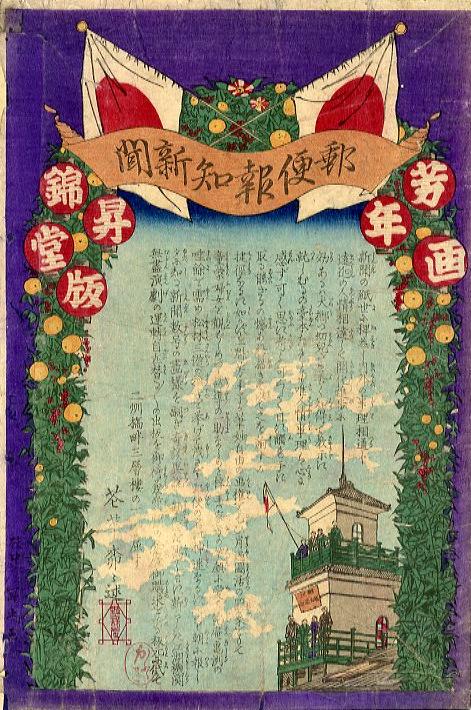
Stage 0 -- Unfurled banner and flowing story
Stage 0 is my designation for the design of the promotional flyer -- a one-off print announcing the forthcoming YHS nishikie series. The overall design is clearly exceptional -- its purple color and unfurled banner.
Unfurled banner and flowing story
The titles and stories of Stage 2 and Stage 3 prints appear in cartouches, but Stage 3 prints feature the fancy unfurled banner and flowing story of the Stage 0 print.
Purple margin
All Stage 1 and Stage 2 prints, and all published Stage 3 prints but one have the purple margin of the Stage 0 print -- overlooking a few variations (probably misprints) with colorless margins.
Not drawn by Yoshitoshi
YHS-0 also differs from other YHS nishikie in that it seems to have been drawn by one of Yoshitoshi's disciples. Printed in black on the dark purple right margin of YHS-0 are the characters 社中年X画 -- meaning "Drawn by Toshinao [X appears to be 尚] of [Yoshitoshi's] circle".
All eight known Stage 2 prints but one (YHS-816) were drawn by Yoshitoshi with the acknowledged assistance of Toshimitsu.
Stage 1 -- 1875 approval seals and boxed stories
Fifty Stage 1 prints are known -- YHS-425a to YHS-702, except YHS-596 and YHS-621, which are Stage 2 prints, and counting variations of several prints as single prints.
Title and story cartouches
All Stage 1 prints (1) enclose the name of the source newspaper and the issue number and the story text in cartouches at the top, (2) are attributed only to Yoshitoshi, (3) show the publisher as Kinshodo, and (4) have an approval seal (aratamein).
Approval seals
The earliest approval seal corresponds to February 1875. The last Stage 1 prints, including YHS-702, have seals for August 1875, the last month such seals were used.
Stage 2 -- Drawings assisted by Toshimitsu
Eight Stage 2 prints are known -- including YHS-596, YHS-621, and YHS-724 to YHS-832.
All Stage 2 prints reflect 3 September 1875 revisions to a 1869 regulation governing printed matter. This explains the rush to get aratame "approval" seals in August -- which marks the end of Stage 1 prints.
Publishing particulars
From September 1875 or so, all woodblock prints, in principle, had to disclose the legal names and street addresses of both their creator (writer or drawer) and their publisher, and an "otodoke" (御届) date stamp -- which showed the Meiji calendar year, month, and day the publisher filed notification of intent to publish -- in lieu of the aratamein (approval seal).
Whereas Stage 1 prints show the approval seal and publisher's name, and sometimes the carver's name, on the lower left margin, Stage 2 and Stage 3 prints show (1) Yoshitoshi's actual name (Tsukioka Yonejiro) and address, in addition to his signature, which is shown in the usual manner on the print, (2) the name (Kumagaya Shoshichi) and address of Kinshodo's owner, in lieu of Kinshodo, and (3) sometimes the carver's name, but in the conventional way.
Unlike Stage 3 prints, Stage 2 prints did not yet have "notification" (otodoke) date stamps. Judging from the edition numbers of the source Tonichi papers, however, all were probably published between September and December 1875, though a couple might have been published in early 1876.
Assisted by Toshimitsu
Art wise, the most remarkable new development in Stage 2 prints is that only one (YHS-816) is attributed solely to Yoshitoshi. All other seven Stage 2 prints acknowledge the assistance of Yoshitoshi's disciple Toshimitsu (年参, who also graphed his name 年充).
Toshimitsu, whose signature appears beside Yoshitoshi's, is called either (1) "hohitsu" (補筆) or "supplementary brusher" (YHS-596, 724, 729), or (2) "monjin" (門人) or "gate person" (YHS-621, 780, 814, 832). The latter more clearly labels him as a "disciple" or "apprentice" who has entered a master's home or workshop to be taught if not also to live.
Different writers
Assuming that Stage 2 prints were published roughly in the order of their issue numbers, it appears that "hohitsu" was used before "monjin". If in fact "monjin" represents a promotion in title, then we could conclude that YHS-621 was published after YHS-729.
Another curiosity about Stage 2 prints is the appearance of Kaka Ryuryu -- and only on prints involving Toshimitsu. Another writer, Nonnonsha Nanryu, makes two of three appearances on the last two Stage 2 prints -- one with only Yoshitoshi (YHS-813), the other with Toshimitsu (THS-832). His other appearance was near the end of Stage 1 (YHS-650).
Series 2
The numbering jumps to the much smaller and significantly later group of YHS prints that I have called Series 2.
Series 2 includes YHS-1127 (Rebellion of Shinpuren in Kumamoto), YHS-1144 (Maebara Issei capture during Hagi rebellion), YHS-1155 (Sukiyacho fire in Tokyo), and an unnumbered keyblock print of similar design. 1127 and 1144 are single sheets, whereas 1155 and the unnumbered print are triptychs.
According to their notification dates, the three numbered prints were published in December 1876. The unpublished triptych has a February 1877 notification date.
This last group of prints all feature, in lieu of the boxy title cartouche of Series 1 prints, an unfurled banner centered at the top with the name Yubin hochi shinbun running left to right. Its design is exactly like that of the banner used on the promotional flyer (YHS-0).
On the right side of the banner of the three published Series 2 prints is the issue numbers -- 1127, 1144, and 1155. On the left side is a series number -- 20, 22, 26.
The text of the stories for 1127 and 1144 are signed and flow in the space around the images -- reminiscent of the Stage 0 design of the promotional flyer (YHS-0). The story text for 1155 is unsigned and boxed in a cartouche next to Yoshitoshi's signature in the upper left corner. The unnumbered keyblock triptych has a long list of names in lieu of a story.
Stage 3 -- 1876-1877 notification dates
All four Stage 3 prints -- consisting of YHS-1127, 1144, 1155, and the unnumbered (apparently unpublished) 9001 -- have an unfurled banner like YHS-0, the promotional print, displaying the name Yubin hochi shinbun.
Series numbers
The banners of YHS-1127, 1144, and 1155 also feature two numbers, on either side of the name: (1) to the right, the number of the issue of YHS in which the story first appeared, and (2) to the left, what appears to be a series number.
The series numbers for YHS nishikie issues 1127, 1144, and 1155 are 20, 22, and 26. Series numbers also appear on Stage 3 Tokyo nichinichi shinbun (TNS) prints, where the numbers increase from 1 to 9 without a break (though two prints bear the number 7).
Why would so many numbers be missing in the YHS series? Have only three prints survived of no fewer than 26? Are others out there waiting to be discovered?
Banners
The four Stage 3 prints show some variation in their design. The banners of the three that were published are differently colored. The banner of YHS-1127 (20) is like same dull orange of the banner of YHS-0. The banner of YHS-1144 (22) is a polychrome banner like most TNS nishikie banners. The banner of YHS-1155 (26) is green. What would the color of YHS-9001 have been?
Borders
The border design is a bit different too. In all four corners of the border of the three published prints is a small design that could be an anchor. And in the middle of four sides is a break like that in the middle of a {brace}. In contrast, the borders of all Series 1 prints are straight and unadorned.
Margins
There is also some variation in margin color. All Series 1 prints have purple margins and none are red. 1127 and 1144 also have the familiar purple margin, but 1155 -- alone among all YHS prints -- has a red margin like TNS prints.
Oju
Whereas Yoshitoshi acknowledged the assistance of his disciple Toshimitsu on all but one Stage 2 print, he is the only drawer credited on Stage 3 prints. As on a few Stage 1 prints, however, his signature appears as "Oju Taiso Yoshitoshi".
Ono translates the kanbun expression "oju" (応需) as "motome ni ojite" (需めに応じて) or "in response to a request" (Ono 1972:10). This and similar terms were commonly used to show that a drawer or writer had been commissioned by the publisher -- in this case Kumagaya Shoshichi.
Stories
Since Stage 3 prints have banners in lieu of title cartouches, what about the stories? The stories on both 1127 and 1144 flow around the images, as they do on Yoshiiku's TNS nishikie, and on many other woodblock series that feature stories, usually signed. The stories on these two prints are signed by Ikuso [tentative reading] Sanjin (育巣散人) -- a new name (though not necessarily a new author) in the YHS writing stable. On 1127, his name, too, is preceded by Oju.
The story on 1155, one of only two tripychs in the YHS nishikie series, is shown, unsigned, in a small rectangular cartouche at the top of the third (left) sheet, thus to the left of the unfurled banner at the top of the middle sheet.
The demise of YHS
The particulars of Behind these particulars is a story that begs to be told but can only be conjectured. The evidence strongly suggests that YHS news nishikie are fighting to survive in a dying market. Yoshiiku and Tentendo, his principle writer, have already bailed out of TNS, which was left to a minor drawer by the name of Yoshimura, who cranked out a few swansong triptychs.
Yoshitoshi, too, was busy with other projects -- including a series called Meiyo shindan (MS) or "New stories of honor and glory" published by Gusokuya, featuring the exact same red margin design used on TNS nishikie, which Gusokuya was cranking out as quickly as he could. The stories on the MS prints are signed by none other than Tentendo Shujin -- who was writing most of the TNS stories.
Talk about a cozy industry. But this tells us worlds about the free, unfettered nature of both drawers and writers at the time. No one owned them. Or perhaps it would be more accurate to say that everyone owned them, for in order to eat they probably had to work for any publisher who came to them with a request to design or write for a new or on-going project. They were no different, really, from day laborers who would dig a ditch, get paid, and go looking for other ditches to dig. And like apple pickers, they did not own the fruits of their labor or get royalties.
Several observations suggest that production dropped because there was less demand for new-related nishikie. There are far more TNS than YHS nishikie on the market, and the fetch a somewhat lower price. This may mean only that YHS prints, because they were done by Yoshitoshi, are in greater demand, and that owners are more reluctant to part with them.
However, it may also mean that more copies of each TNS nishikie were printed, circulated, and thrown into drawers, closets, and storage sheds. In other words, TNS nishikie may have enjoyed higher circulations at the time, and thus survived better -- quite apart from Yoshitoshi's greater popularity today, though his YHS nishikie have hardly been among his best-liked works.
It also seems to me, however, that comparatively fewer copies of the later issues of both news nishikie series come to the market. I suspect that, as the novelty of new nishikie wore off, and other forms of illustrated reading matter appeared, publishers simply printed fewer copies of the later issues.
In contrast with the later issues, many of the earlier issues of both series were reprinted. In the case of TNS, the blocks of some issues were even sold to another publisher, who knocked off as many copies as the blocks, or the market, could bear.
Stage 3 was probably an attempt -- a failed attempt -- to inject some new life into the YHS series in the hope that it might continue. Perhaps someone thought that, starting a new series with a new masthead design (returning, in fact, to the original design) would attract more interest -- but apparently not.
Thematically, it is worth noting that, of the four last YHS prints that survive -- the Stage 3 issues and the unnumbered triptych -- three deal with uprisings over the unfinished business of the Boshin Wars, the unnumbered print actually comes out in 1877 about the time the Seinan War begins -- the final battle, really, of the Boshin War.
As the Seinan War drags on, for months and months, Yoshitoshi and many other drawers are kept busy with requests to draw every battle that grips the public's attention in an age when there is no radio or television, and a practically insatiable thirst for visual depictions of bravery, victory, and defeat. The war gives birth to many one-off news nishikie, and some very short-lived news nishikie series, dedicated to stories of Seinan War battles. A trickle of what could be called news nishikie follow the war, but the war really marks the end to this genre of illustrated news.
Numerous triptychs were produced mostly to glorify bravery and victories in the Sino-Japanese war of 1894-1895, and again in the Russo-Japanese War of 1904-1905, but they were mostly pictures, and did not include stories or otherwise compete with what was by then a flourishing broadsheet and even magazine news industry supported by photography.
Highlights of Stage 3 YHS prints
Stage 1 and 2 prints span 1874 and 1875. About a year elapses between the last Stage 2 print and the fall of 1876 when the four known Stage 3 prints are published.
The themes Stage 1 and 2 prints cover the entire spectrum of human interest stories, taken from the Yubin hochi shinbun. One Stage 3 print is about a spectacular fire, and the other three known to us are on rebellions flaring up in southwestern Japan.
In other words, Stage 3 prints are not motivated by a market for human interest stories, but by a craving for visual images of recent civil dicturbances and spectacular tragedies.
As the following table shows, one or two months elapse between the dates of the events and the publishing of the nishikie. The Sukiyacho fire print appears to have been published the most quickly.
| Stage 3 YHS News Nishikie | ||||||
|
Most of the data in this table was compiled by examining the prints in Tsuchiya Reiko's Nihon nishikie shinbun shusei (Tokyo: Bunsei Shoin, 2000), a CD-ROM containing large scans of practically all known news nishikie. The data on YHS-1155 was confirmed by personal correspondence with the curator at the Philiadelphia Museum of Art. |
||||||
| Issue | Series | Sheets |
Date of incident in story |
Date of story in paper |
Date on otodoke stamp |
Story |
| YHS-1127 | 20 | Single | 1876-10-25 | 1876-10-29 | 1876-12-22 | Shinpuren rebellion |
| YHS-1144 | 22 | Single |
[1876-10-28 1876-11-05] |
1876-11-20 | 1876-12-22 | Hagi rebellion |
| YHS-1155 | 26 | Triptych | 1876-11-29 | 1876-[12-??] | 1876-[12-??] | Sukiyacho fire |
| YHS-9001 | Proof | Triptych | [1876-10-24] | 1876-[??-??] | 1877-02-?? | Shinpuren names |
|
Notes 1. Related files for all prints in the table are named "YHC-1234" on Tsuchiya's CD-ROM, as she uses "YHC" to designate "Yubin hochi shinbun" nishikie files. 2. The stories on 1127 and 1144 are both signed by Ikuso Sanjin [tentative reading] and flow around the image. 3. Only 1144 bears the name of its carver -- Hidekatsu. 4. The otodoke dates of 1155 may be the same as 1127 and 1144. 5. The boxed story on 1155 is unsigned -- unless the placement of Yoshitoshi's signature to the left of the story was meant to signify that he wrote the story in addition to drawing the picture. 6. YHS-9001 is an unnumbered stillborn triptych -- a black keyblock proof. It has no story but only a list of names in a box that sweeps across the top. |
||||||
